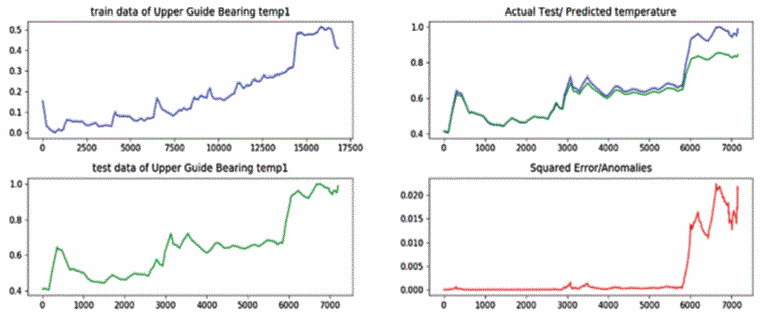MonitorX
Case C5 - Condition monitoring of generator bearings
Bearings are important generator and turbine components that have been known to cause problems when aging, such as vibrations, bearing wear, lubrication problems or misalignment. The aim of this case is to develop algorithms for early detection of bearing degradation or faults using available SCADA data.
To enable dynamical condition monitoring, models that predict the normal behaviour of bearing temperature have been built and tested using artificial neural networks (ANNs). Both multilayer perceptron, recurrent neural networks, self-organizing maps and long short term memory (LSTM) neural networks have been tested. The models predict the normal relation between multiple parameters, such as power, bearing temperature and bearing vibration. Comparing the model predictions with actual measurements, deviations from normal behaviour can be identified.
The challenge for the selected examples (Dale and Nygard power plants) is that the data sets for which the models have been trained and tested do not represent a period of stable normal behaviour, because a degradation process (bearing wear) is ongoing, resulting in a continuously changing situation with increasing damage and bearing temperature. This resulted in less than ideal results for models built with multilayer perceptrons and recurrent neural networks.
To overcome this problem, a long short term memory (LSTM) neural network model was tried [1]. LSTM is one of the most successful modern recurrent neural networks architectures for sequence learning tasks. An LSTM model was built for the Nygard power plant to predict the current bearing temperature from a sequence of foregoing measurements of the temperature. Selected results are shown in the figure. The upper left diagram illustrates the training of the model, the lower left diagram the testing of the model, the upper right diagram the testing of the model compared with actual measurements, and the lower right diagram the model error (the difference between the predicted and measured values). It is in the two right diagrams seen that the model at first predicts the increasing bearing temperature well, but that the prediction gradually deviates from the actual measured values. This is seen as a sign of anomalies, i.e. that the way in which the bearing temperature is increasing is changing.

LSTM based prediction of upper guide bearing temperature. Courtesy of J. Yuan [1].
Finally, a clustering technique was tried for the Nygard power plant [2] using data for active power, guide vane opening and bearing temperature. It was illustrated how such a technique can identify and illustrate patterns of normal behaviour for the bearing in terms of these parameters. The technique yielded promising results for tracking the abnormal bearing temperature developing at Nygard.
[1] J. Yuan, Y. Wang, and K. Wang, "LSTM Based Prediction and Time-Temperature Varying Rate Fusion for Hydropower Plant Anomaly Detection: A Case Study," in Advanced Manufacturing and Automation VIII, 2019, pp. 86–94.
[2] P. C. Báscones and M. Á. Sanz Bobi, "Anomaly detection method based on the evolution of patterns in industrial components. Application to a hydropower plant," paper draft, 2019.